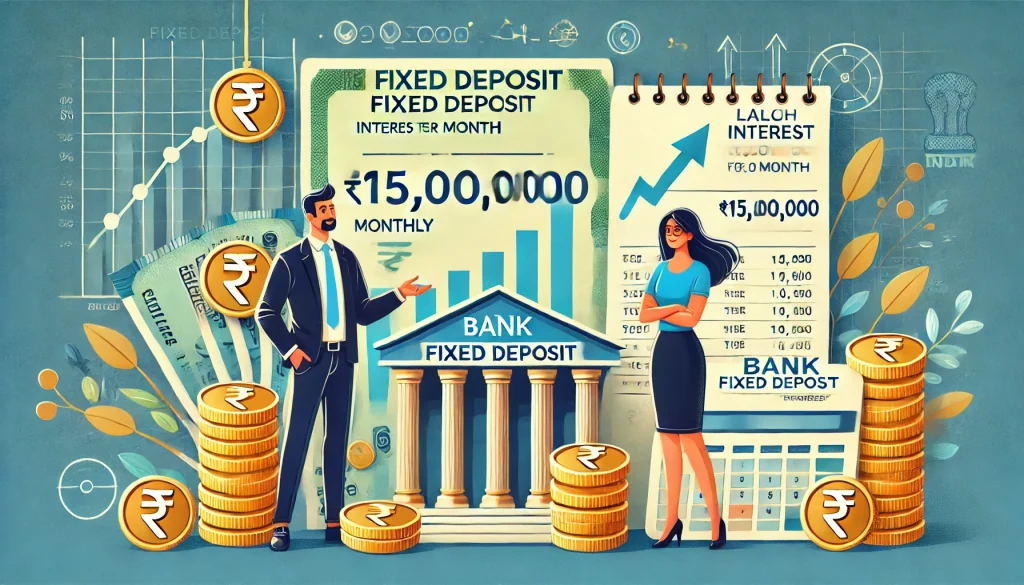
Fixed deposit is a popular option for investment, especially if you want to save your money with assured returns and risk-free. However, before applying for a fixed deposit account with banks or NBFCs, you must have an explicit knowledge and understanding of tax implications on your earnings. Tax Deducted at Source or TDS is one of the most critical tax implications you must have an idea of. Let’s explore the different aspects of TDS on Fixed Deposit interest.
What is TDS on Fixed Deposit?
TDS stands for Tax Deducted at Source, which is a system introduced by the Indian Income Tax Department to collect taxes at the time of payment itself. TDS is deducted by banks or Non-Banking Financial Companies according to all guidelines of the Income Tax Act on any interest earned from FDs.
Banks generally deduct TDS while crediting your FD interest. 10% TDS on interest on fixed deposits applies to individuals when the interest earnings are above ₹40,000 during a financial year. In the case of senior citizens, the applicable TDS rate is 10% when interest earned is more than ₹50,000. Nonetheless, individuals will be charged TDS at a rate of 20% if they fail to show their PAN information related to the FD account.
Individuals having a total taxable income less than ₹2.5 lakhs are eligible to claim exemption from paying TDS on their fixed deposit accounts. Also, as per the Income Tax Act, FD interest earned in excess of ₹5 lakhs or ₹10 lakhs is entitled to additional tax deductions of 10% and 20%, respectively, in addition to TDS.
At the end of each financial year, the bank or NBFCs automatically deduct TDS from your FD. Moreover, any interest gained from the tax-saving FD schemes is also subject to a deduction of TDS.
How is TDS on Fixed Deposit Interest Rate Calculated?
The calculation of TDS on FD interest depends on various factors, such as – the interest amount and the depositor’s PAN (Permanent Account Number). The applicable TDS rate is applied to the interest earned.
While you may not receive an instant payout, including interest income in your total annual income is critical when filing your Income Tax Return (ITR). Make sure to include interest income when filing your ITR in the “Income from Other Sources” section and check your applicable tax bracket.
The income tax department will reconcile the Tax Deducted at Source (TDS) that has already been deducted to balance your ultimate tax burden. Refer to your Form 26AS for further information on the TDS taken from your wages.
Let us take a look at an example of how your TDS on a fixed deposit is calculated.
For instance, Mr Raj has 2 FDs of ₹3 lakhs each with a bank. The tenure of the FDs is 4 years, with a 4% applicable interest rate.
Hence, the total interest earned on both FDs each year is ₹60,000, i.e., ₹30,000 each for every FD.
Then, the total interest Mr Raj earns for 4 years on both his FDs is ₹2,40,000.
The applicable TDS rate for Mr Raj is 10%.
Therefore, the TDS on the FD interest of Mr Raj is 10% of ₹60,000, that is, ₹6,000 per year.
TDS on Fixed Deposit Interest Rates for Different Customers
The interest rates of TDS on bank fixed deposit interest earnings differ for various financial institution customers. Let’s explore the two categories of customers who need to pay TDS on their income and the applicable tax rate.
1. Senior Citizen
As per the latest regulations of the Income Tax Act, the TDS rate applicable to senior citizens is 10%. Such individuals are eligible for tax deductions on income of up to ₹50,000. However, if you are unable to show your PAN card while applying for the FD account, the TDS rate applicable will be 20%.
2. General Public
In the case of the general public having an FD account, the TDS rate applicable is 10%. The income on interest of above ₹40,000 will be eligible for TDS deductions. Nonetheless, without the availability of PAN cards, the TDS rate rises to 20% on the interest income.
If your annual income, including the interest earned from FD, is less than the basic exemption threshold, you can provide Form 15G or Form 15H to your bank. This serves as a formal request to exempt your interest income from the TDS deduction. Moreover, if you fall under a higher tax bracket, there might be a need to settle additional taxes on the interest income generated from FDs beyond what the bank deducts as TDS.
3. NRI
For Non-Resident Indians (NRIs), the TDS rate on FD interest is 30% if the interest income exceeds the specified threshold.
Ways to Reduce TDS on Fixed Deposit Interest
You can implement a few essential techniques to reduce your TDS deduction on FD. They are as follows.
1. Submitting Form 15G or 15H
If you have a total income of less than ₹2.5 lakhs in a financial year, you can submit Form 15G or Form 15H. This form will ensure that your bank will not deduct any TDS on your FD income as your total income does not fall under the taxable range. You are not liable to pay any taxes in such scenarios.
2. Investing in Post Office FD Schemes
Investing your money in different FD schemes of the Post Office can be highly beneficial in reducing TDS on your interest income. This is because TDS deductions under the Income Tax Act do not apply to Post Offices FDs.
3. Investing in the Name of Family Members
The TDS on bank FD interest earnings is calculated for individuals. Therefore, if you invest your money in FD in the name of your different family members, you reduce your own tax liability if your total income falls under the taxable slab.
4. Choosing the Right Time to Invest
You can save your money in FD schemes at the right time of the year and can save TDS deductions on your income. If you book your FD in the middle or close to the end of the fiscal year, the TDS deduction is distributed to two different financial years. As a result, your interest for one fiscal year can be ₹10,000, for which no deduction of TDS will happen.
5. Having FDs in Different Financial Institutions
Opening fixed deposits in different banks or branches can help you reduce or save TDS on your income. Distributing your FDs will lower your interest income from each bank, and if the income falls below the threshold, no TDS will be applicable on your income.
Who Deducts TDS on FD Interest?
Tax Deducted at Source on your fixed deposit schemes is generally deducted by the bank or the NBFC with whom you have invested your money. At the end of each financial year, until the end of the FD tenure, the bank is responsible for deducting your TDS on FD interest income as per applicable rates.
When is TDS Deducted?
TDS on bank FD is deducted when the interest amount on your fixed deposit is credited to your account. Such deductions never happen after the FD matures. This suggests that TDS will be deducted each financial year till the maturity period is over.
How to Pay TDS on Fixed Deposits Interest?
Your interest income from a bank or NBFC fixed deposit scheme is taxable as per regulations of the TDS on Income Tax Act 1961. Hence, individuals can use the Challan 281 form available on the Income Tax Department’s website to pay TDS on fixed deposits. The form can be filled with the necessary details and submitted along with the tax amount to the authorised bank.
Conclusion
Overall, understanding the Tax Deducted at Source is important when booking a fixed deposit with any financial institution. TDS on FD interest income is taxable under different rates, as we have discussed above. Thus, before applying for any FD scheme, always plan your finances so you can save or reduce your TDS and enjoy a little extra money to fulfil your wishes.
FAQs
Disclaimer
This article is solely for educational purposes. Stable Money doesn't take any responsibility for the information or claims made in the blog.


